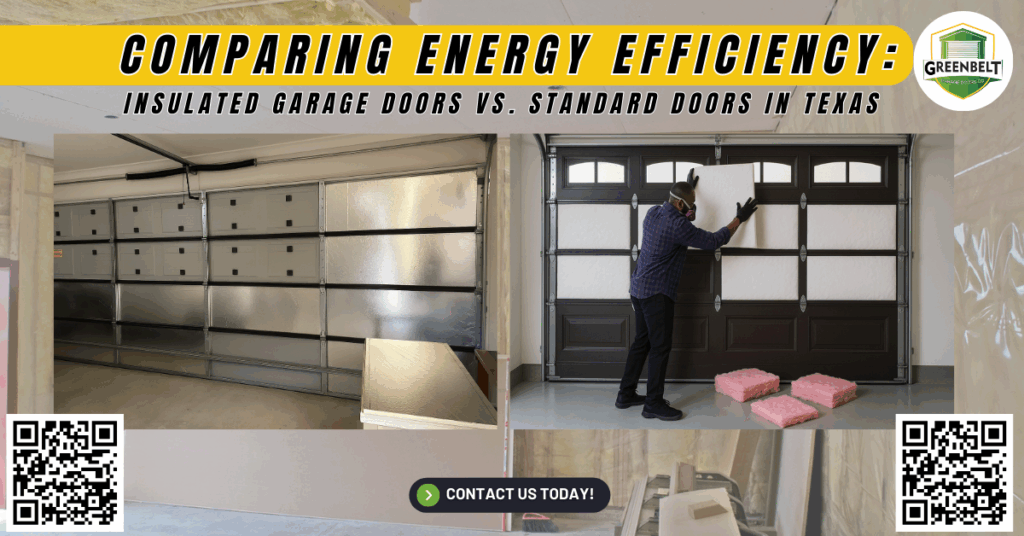When a Garland homeowner reached out to us last July, they were concerned about extreme heat seeping into their house. Their car garage door was a basic, non-insulated steel panel door. Our technicians quickly diagnosed the issue: intense summer temperatures were transferring directly into the garage space, increasing their energy bills significantly. After installing new insulated garage doors with thick polyurethane foam panels and a high R-value, the results were immediate. Not only did the garage maintain a stable temperature, but the energy savings also reflected in the homeowner’s next bill.
Garage spaces can become heat traps in the Texas summer. With temperatures soaring above 100°F, a garage without proper insulation becomes a major source of energy loss. According to national energy efficiency studies, around 30% of a home’s heating and cooling can be affected by poorly insulated garage doors. Investing in a better solution, such as an insulated garage door, can go a long way in improving energy efficiency and reducing costs.
Many Texas homeowners and business owners are now considering the benefits of insulated garage doors. This guide compares insulated garage doors and standard doors, explaining their impact on your garage, energy bills, and home comfort. Whether you’re in Garland or the surrounding areas, this article provides a clear breakdown of the pros and cons, insulation materials, and garage door options best suited for Texas weather.
What Is an Insulated Garage Door?
An insulated garage door is built using multiple layers of materials, such as steel, aluminum, and insulation materials like polyurethane or polystyrene. These types of doors are engineered to reduce thermal transfer and stabilize the temperature inside your garage space. Most insulated garage doors use rigid foam insulation sandwiched between steel panels. These layered doors come in different door types like sectional doors, single doors, and craftsman garage doors.
Insulation types include:
- Polyurethane insulation: A high-density foam sprayed into the door panels, offering a higher R-value and greater energy efficiency.
- Polystyrene insulation: A rigid foam sheet is inserted into the door panels. It offers moderate R-values and is generally more affordable.
- Batt insulation or insulation kits: Used in retrofitting existing doors. Includes fiberglass or foam-based material that can be added to improve performance.
In contrast, standard garage doors are usually constructed with a single layer of metal or wood, lacking any thermal barrier. These non-insulated doors have low R-values, which means they allow heat and cold to pass through easily. They are more affordable at the initial cost, but they may contribute to higher long-term energy bills.
Why Insulation Matters in Texas
Texas experiences intense seasonal shifts: scorching summers and occasional chilly winters. If your garage shares walls with living areas, non-insulated garage doors allow heat transfer and cold drafts into your home. This results in energy inefficiency, discomfort, and higher energy bills. Insulated garage doors, on the other hand, create a barrier that minimizes energy loss and improves climate control.
Insulated doors help:
- Maintain a consistent garage temperature year-round
- Reduce energy loss through adjoining walls
- Protect stored materials such as paint, tools, and electronics from temperature fluctuations
- Improve heat insulation during winter and block heat gain during summer
In Texas, where garages are often used as workshops, gyms, or utility rooms, insulated garage doors turn them into more usable spaces. Whether you’re operating a Chamberlain garage door opener or a Martin garage door, insulation enhances overall efficiency and function.
Comparing Energy Efficiency and R-Values
| Feature | Insulated Garage Door | Standard Garage Door |
| Layers | 2 to 3 (steel + insulation + backing) | 1 (steel, aluminum, or wood) |
| R-value | High (R-9 to R-18 or more) | Low (R-0 to R-3) |
| Energy Efficiency | Excellent | Poor |
| Temperature Control | Stable | Fluctuates |
| Noise Reduction | Significant | None |
| Durability | High | Moderate to Low |
| Initial Cost | Higher | Lower |
| Long-Term Savings | Excellent Return on Investment | Minimal |
| Ideal Insulation Materials | Polyurethane, Polystyrene | None or low-density material |
R-value is a key term used in garage door guides to measure resistance to heat flow. The higher the R-value, the better the door insulates. In Texas, we recommend garage doors with R-values of at least R-12, especially for attached garages.
Extra Benefits of Insulated Garage Doors
Choosing insulated garage doors provides more than just temperature control:
- Noise Reduction: Insulated panels dampen vibrations and external noise, creating a quieter garage environment.
- Increased Strength: Multiple layers of steel and foam increase door strength and resistance to dents, storms, and everyday wear.
- Improved Functionality: Insulation enhances the performance of your garage door opener and logic board, especially in extreme temperatures.
Home Value: Insulated garage doors from brands like Amarr Garage Doors, Clopay Garage Doors, or Craftsman Garage Doors are desirable upgrades for energy-conscious buyers. - Aesthetic Options: A wide range of door types, colors, panels, and window inserts are available in insulated models.
With the right garage door insulation kit or professional installation, you can turn your basic garage into an energy-efficient extension of your home.
Is It Worth the Investment?
While insulated garage doors carry a higher initial cost, the return on investment is substantial for Texas homeowners. By reducing the load on HVAC systems and improving indoor climate control, you can:
- Lower your monthly energy bills
- Extend the lifespan of heating and cooling equipment
- Protect your belongings stored in the garage
- Make the garage more comfortable for daily use
Many customers in Garland report saving hundreds of dollars annually by switching from non-insulated doors to energy-efficient insulated garage doors. These savings, combined with increased comfort, justify the upgrade.
Best Garage Door Options for Texas Homes
If you’re shopping for a new garage door or considering an upgrade, consider these top choices:
- Steel sectional doors with polyurethane insulation: High R-values, superior durability, ideal for weather resistance.
- Aluminum and fiberglass doors with foam insulation: Lightweight and rust-resistant, good for humid climates.
- Wood composite doors with added insulation: Offer a traditional look with improved thermal performance.
- Custom insulated doors: Ideal for homeowners needing specific dimensions or design features.
Garage door guides recommend pairing these with reliable brands like Clopay, Amarr, or Martin Garage Doors for best results. Don’t forget accessories such as weather seals, bottom seals, and thermal breaks that enhance insulation performance.
How Can Greenbelt Garage Doors Co. Help You?
At Greenbelt Garage Doors Co., we understand how important it is to choose the right garage door for your Texas home. Whether you’re interested in improving energy efficiency, enhancing curb appeal, or making your garage more functional year-round, we have the expertise to help.
Our services include:
- Free in-home consultations with insulation and R-value recommendations
- Installation of energy-efficient insulated garage doors
- Retrofits using professional-grade garage door insulation kits
- Maintenance and repairs on all door types, openers, and insulation products
We specialize in residential and commercial projects across Garland, TX, and surrounding areas. Our expert technicians are trained to handle all garage door systems, from basic setups to smart garage door openers and logic boards.
Address: 1824 N 1st St, Garland, TX 75040, United States
Phone: (469) 369-1721
Call now or schedule an appointment to explore the best insulated garage door options for your home or business. Let Greenbelt Garage Doors Co. provide you with reliable, energy-efficient solutions that stand up to Texas weather.
Frequently Asked Questions (FAQs)
1. Can I add insulation to my existing garage door instead of replacing it?
Yes, you can use a garage door insulation kit with materials like rigid foam or fiberglass batts to retrofit standard doors, but it won’t be as effective as a factory-insulated door.
2. Does garage door insulation help during the winter months in Texas?
Absolutely, insulated doors help retain indoor heat during colder months, keeping your garage and adjacent rooms more comfortable.
3. Will insulation affect the performance of my garage door opener?
Heavier insulated doors may require a slightly more powerful opener, but most modern openers can handle the added weight with proper calibration.
4. How do I know if my current garage door is insulated?
Check the inside of your door. If you see a solid, layered interior with foam or thick material between panels, it’s likely insulated; single-layer metal doors usually aren’t.

